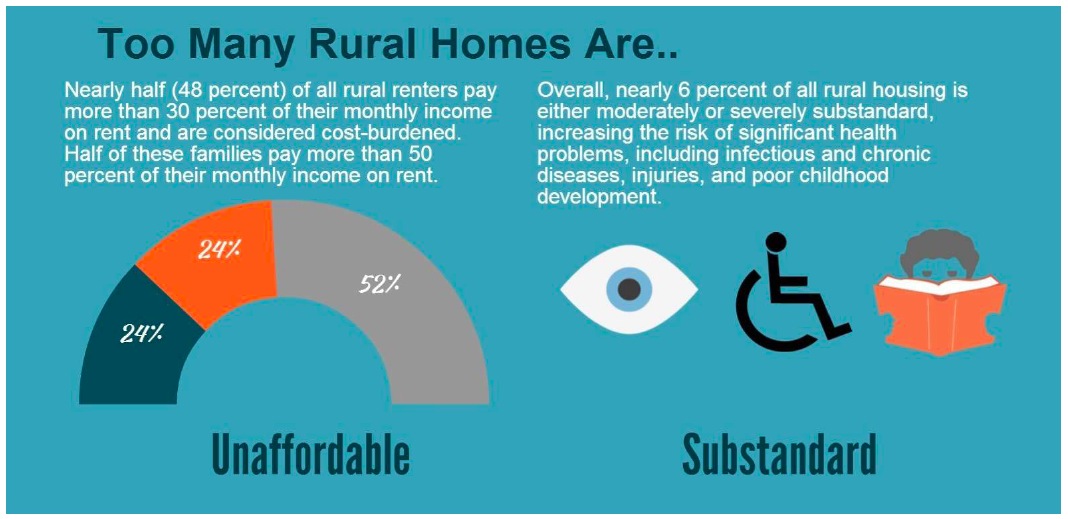NATIONAL RURAL HOUSING COALITION
Federal Strategies to Preserve Access to Affordable Rental Housing in Rural Communities
Executive Summary
For several decades, communities in rural America have struggled to provide access to clean, decent, and affordable housing. With lower incomes and higher poverty rates, rural renters—including aging seniors, individuals and families with very low incomes, persons with disabilities, and farmworkers—face especially daunting barriers to affordable housing.
Over the past 50 years, the U.S. Department of Agriculture (USDA) has used a three-part strategy to effectively overcome these barriers. First, with direct Section 515 Rural Rental Housing Loans (Section 515) and Section 514/516 Farm Labor Housing Loans and Grants (Section 514/516), USDA has financed the construction of more than 500,000 units of affordable rental housing. Second, since 1987, USDA has provided financing to preserve the long-term, affordable use of these properties. Lastly, through its Section 521 Rural Rental Assistance (Section 521) program, USDA has helped keep rents affordable for vulnerable residents.
Because of USDA investments, rural America has an extremely valuable asset: affordable rental housing for some of its most vulnerable residents. Today, more than 400,000 rural families live in housing developments financed and preserved through USDA’s multifamily housing programs. The vast majority of these tenants (94 percent) have very low incomes, earning less than $12,000 a year on average. For many rural communities, USDA is the only source of affordable rental housing available.
In recent years, efforts to improve rental housing conditions in rural America have stalled. Congress and the Administration have all but eliminated the new construction of rural rental housing developments. USDA halted the new construction of affordable housing under the Section 515 program in 2012. Today, the only USDA Rural Housing program that finances new construction of rental housing for low-income individuals and families is the Section 514/516 program, which finances only 600 units of farmworker housing annually.
As a consequence, the two remaining elements of USDA’s rental housing strategy—the preservation of its existing portfolio and the sustainability of its rental assistance program—have become the main focus of federal rural rental housing policy. Yet, both must overcome significant short- and long-term challenges.
Without immediate action and a clear set of objectives aimed at preserving USDA’s portfolio, rural communities stand to lose much of their affordable rental housing stock. To date, more than 93,000 units of affordable rental housing developed with USDA financing have exited the program, either through the prepayment of USDA loans or through the end of loan terms. According to USDA, none of the remaining properties in its portfolio have the capital reserves necessary to meet ongoing maintenance and operational costs.
USDA’s preservation efforts include a demonstration program to restructure existing loans and offer additional assistance and financial incentives provided to owners in exchange for maintaining properties as affordable housing. To date, these programs have been limited and fall far short of the estimated $2.6 billion that is needed over the next 20 years. Moreover, the Department’s preservation efforts were further weakened in 2012, when USDA announced that it would no longer fund its financial incentives program.
USDA’s rental assistance program has also reached a crisis point. Over the next several years, the rental assistance program is expected to continue to grow to over $1.3 billion annually, putting the entire USDA Rural Housing budget at risk. Neither USDA nor Congress has adequately funded the program. In fact, both have resorted to budget gimmicks to reduce funding in the short-term, only to see long-term costs increase. More recently, USDA proposed additional policy changes aimed at reducing the burden on its rental assistance program—with mixed reviews from housing developers and advocates who are concerned that these proposals will harm tenants and properties.
In light of these new budget realities, the purpose of this report is to analyze federal strategies to preserve affordable, rural rental housing. In addition, this report identifies workable policy solutions to help Congress and the Administration use its limited resources to most effectively serve low-income, rural individuals and families. Most importantly, these policy solutions aim to resolve USDA’s Rural Housing budget crisis, while protecting tenants from losing access to affordable housing, preserving the entire multifamily housing portfolio, and strengthening the quality and sustainability of the portfolio for future generations.
Download full version (PDF): Rural America’s Rental Housing
About the National Rural Housing Coalition
ruralhousingcoalition.org
In 1969, a group of concerned rural community activists, public officials, and non-profit developers formed the National Rural Housing Coalition (NRHC) to fight for better housing and community facilities for low-income rural families. Today, NRHC works to promote and defend the principle that rural people have the right — regardless of income — to a decent, affordable place to live, clean drinking water, and basic community services.
Tags: National Rural Housing Coalition, Rural, U.S. Department of Agriculture, USDA







 RSS Feed
RSS Feed